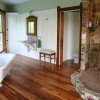This Old House Magazine
October 2009
“There were bullets in the siding and bars on the windows”
Sure, the house had seen tough times. But one determined couple saw past the deteriorating shell and, using a mix of salvaged materials and sweat equity, breathed new life into the 1911 bungalow.
By Kara O’Brien, homeowner
Photographs by Deborah Whitlaw Llewellyn
Styling by Brian Carter
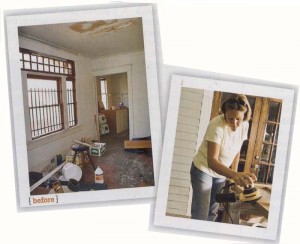
Iron bars safeguarded the living room’s bank of windows–a reminder of when drive-bys and robberies were common (BEFORE). Homeowner Kara O’Brien sands one of the dozen interior doors she refinished for the house.
I wanted to buy this house from the first time I laid eyes on it, back in 1998. It was just so sad looking. I thought, I need to fix it up.
The 1911 bungalow was one of three vintage houses that sat in a row on the same block in the Kirkwood neighborhood of Atlanta, Georgia. While the area was starting to revitalize, the house bore the marks of its rough recent history: Iron bars secured the living room windows, and bullets were lodged in the siding. We learned at the closing that two people had been murdered on the site.
Still, the solid heart-pine house had character and potential, even if its cedar shingles and roof were rotting from neglect. We desperately wanted to save it.
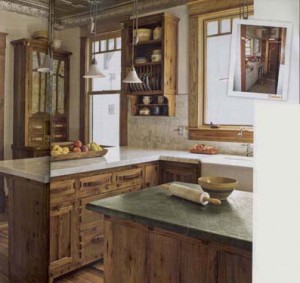
When the house was split into three apartments, one of the kitchens was shoe-horned into the back porch (BEFORE), now the site of the new larger kitchen. Inspired by Greene and Greene designs, the cabinets were milled out of old oak floor joists and accented with walnut on the handles and drawer sides. The room’s tin ceiling is 100 years old, though it’s as good as new, having been stored and never used.
But the owner, who showed up every three months to mow the lawn, refused to sell, though he rented it just once in five years. So my partner, Paula Rose, and I settled for the house next door, where we had our daughter, Walker. For five years, we watched the place go neglected. We’d sit on our back deck and see squirrels, opossums, and raccoons run in and out of the holes in the house. The backyard was a 12 foot high patch of kudzu.
Then one day the owner changed his mind about selling and we leapt at our chance. We bought the house in 2005 and immediately began gutting the space–but saved everything of value. Originally, we meant to just remodel and sell the house because we loved living next door. Having turned a restoration hobby into a business years ago, Paula and I simply wanted to restore the place with integrity before someone tore it down. We did some detective work to figure out the original layout of the house, which had been converted to a triplex in the early 1970s, and began tearing down the rotted back porch turned kitchen to make room for an addition to expand the interior’s 1500 square feet. We wanted to restore and rebuild the house in a way that created the smallest carbon footprint possible, so we reclaimed and reused as much material as possible. We also choose eco-friendly systems when we could, including a tankless water heater. We thought the house would be a challenge, but nothing extraordinary.
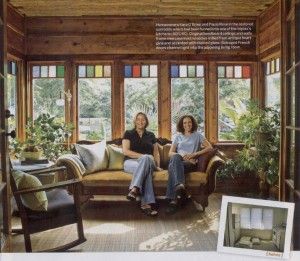
Homeowners Kara O’Brien and Paula Rose in the restored sunroom, which had been turned into one of the triplex’s kitchens (BEFORE). Original beaded board ceilings and walls frame the new casement windows milled from antique heart pine and accented with stained glass. Salvaged French doors channel light into the adjoining living room.
Well, we were in for a surprise. A few weeks into the project, Paula and I went on vacation. While driving through Puerto Rico, we got word that the third vintage house on our block had been set on fire, and the blaze threatened both the house we were working on and the one we were living in. Both homes survived the massive blaze with no structural damage, but it was a close call. Sadly, the fire did kill a 200 year old oak next door. While losing such a great old tree was tragic, I talked the tree surgeon into leaving me the two truckloads of wood chips that it had become. I spent weeks carting a bit every day until I had shoveled a one foot deep layer of mulch onto the front yard. Previously, the dirt was red clay and incredibly acidic, but everything I plant just goes nuts now.
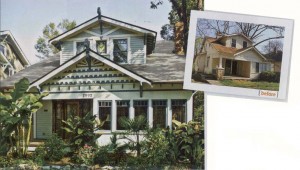
Boarded up windows and bland beige siding adorned the once chopped up home (BEFORE). Now, white and cool green paints highlight the architectural features–including replicated horse-head shaped gable adornments–on the restored 1911 bungalow.
Inside, Paula worked with an architect to design the new back end, which would hold a whole new kitchen downstairs and new bedrooms and master suite upstairs. What we wanted to do was keep the public parts of the house original and upgrade the spaces that people didn’t really care about in 1911–like the kitchen, bathrooms, and bedrooms. Meanwhile, I set up shop in the backyard to sand and shellac all of the interior doors. It was labor-intensive. We had a pro strip the doors, which I sanded by hand before finishing off with amber shellac. I finished about three doors a day.
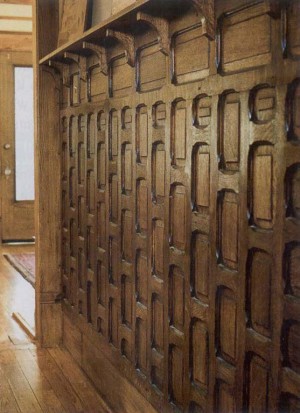
Quartersawn oak winsot with a unique “tiger” grain and chamfered detailing lines the center hall on the first floor. It was salvaged from a late 1800s Tennessee mansion.
We also had a crew dig out the basement so that we could pour a concrete floor and store the salvaged architectural materials that we accumulate for work there. After a week of having two guys cart out wheelbarrows of dirt for 8 hours a day, we had a mountain in our backyard. We used some to flatten out the yard’s slope, and the rest we offered free on Craigslist to anyone willing to pick it up. Surprisingly, we got enough takers that there wasn’t any left over to haul away.
We scoured salvage yards and found amazing pieces: antique stained glass from Ohio, a 19th century filigree light from Virginia, and an 1890s pink granite sink. When we bought the grand, salvaged mahogany mantel for the living room fireplace that we uncovered under drywall, I knew that I had to move in. Somehow, I persuaded Paula. I mean, how difficult could it be to move next door?
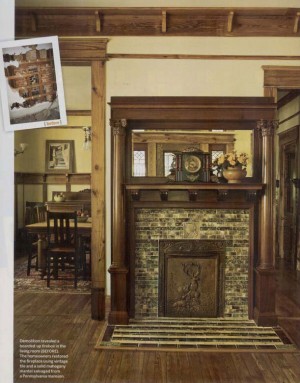
Demolition revealed a boarded up firebox in the living room (BEFORE). The homeowners restored the fireplace using vintage tile and a solid mahogany mantel salvaged from a Pennsylvania mansion.
Well, it was horrible. We immediately got a great offer on our house that we couldn’t turn down. Then I realized, Uh-oh! The new house isn’t ready. For a few weeks, we packed our our two Siberian huskies, three cats, and 4 year old daughter into one of our rental properties. But tenants got their timelines confused and moved in a few weeks early.
We had no choice but to move into a still unfinished house that had power to only two outlets but lots of soy insulation. With one of Atlanta’s worst heat waves coming through that summer, the house was an inferno.
Even with all of the windows thrown open and battery powered fans going, the outside air was cooler than the inside–and it was 111 degrees outside. This went on for four weeks, until we passed our wiring inspection and could run the central air conditioning. We didn’t have the kitchen one for nine more months, but we didn’t care. Washing dishes in the tub was no big deal after that misery.
That’s not to say that life was suddenly comfortable. It had been a while since I’d lived through a remodel. But after spending a few months in our own dusty, noisy, chaotic construction site, with all of our belongings boxed up, I have a lot more empathy for our clients.
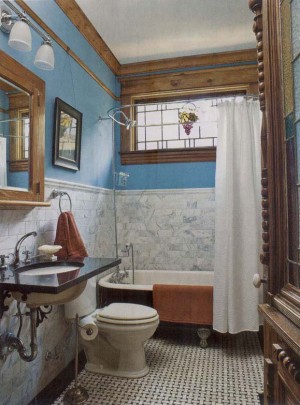
The claw-foot tub in the downstairs bath was original to the house. Relocated from the second floor and refinished, it rests on the new marble basket weave tile surrounded by honed marble wainscot. A salvaged stained glass window lets in light without compromising privacy.
The kitchen turned out to be a painful but rewarding process. It was seriously ambitious, since it involved milling 100 year old oak floor joists with walnut accents into new, handcrafted cabinets. Several contractors said they just couldn’t do them; others quoted us prices that would have bought us a luxury car. We finally hired someone who was inexperienced at custom cabinets but seemed eager to learn. Halfway through, none of us were happy, so we found a cabinetmaker who said he lived for a challenge. He turned out great, and now we work with him often.
We try to outdo ourselves with each project, but now, two years later, we still think it would be very hard to top this kitchen. That’s how much we love and appreciate it.
We can’t really imagine living anywhere else. Despite all the obstacles thrown our way during the remodel, we would do it all over again–if we had to.
What We Did
Restored and expanded a chopped-up unloved 1911 Craftsman bungalow into a polished beauty.
Remodeling costs: $330,000
Time Frame: 2 years 2 months
Where We Saved: Finishing all the woodwork and doing all the landscaping ourselves
Where We Splurged: The kitchen, first and foremost.
What we would do differently: Install radiant heating in our daughter Walker’s bath. The marble gets very cold.
Our biggest challenge: Living through a killer heat wave in an unfinished but insulated house with no air-conditioning.
How we solved it: Going to the movie theater to cool off whenever we thought we had reached the end of our rope.
Floor Plans: The homeowners converted the triplex back to a single home. A rear addition allowed for an expanded kitchen, new office, porch and bath downstairs and two bedrooms and a bath upstairs.


